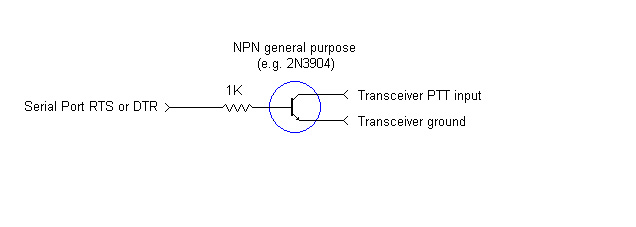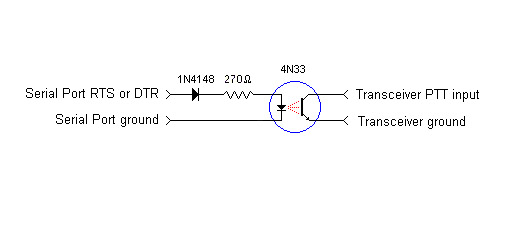Connecting an Icom Transceiver to your PC
Computer control of the IC-7100, IC-7200, IC-7300, IC-7410, IC-7600, IC-7610, IC-7700, IC-7850, IC-7851, IC-9100, and IC-9700 is accomplished with a simple USB transceiver-to-computer connection.
Computer control of older Icom transceivers is accomplished via a bidirectional CI-V bus, which uses an asynchronous protocol communicated via TTL voltage levels. Thus an external interface between your Computer and your transceiver's CI-V jack is required. The basic function of the interface is voltage level conversion from the RS-232 levels used in a standard serial port (+12 and -12 VDC) and the TTL levels used by your transceiver's CI-V bus (+5, and 0 VDC). The interface itself requires power, which can be provided either externally, or with some interfaces by using one of the serial port modem control signals as a power source.
Recent Icom transceivers can be switched between RX and TX using CI-V commands: IC-756Pro, IC-756ProII, IC-756ProIII, IC-7000, IC-7100, IC-7200, IC-7300, IC-7410, IC-7600, IC-7610, IC-7700, IC-7800, IC-7850, IC-7851, IC-9100, and IC-9700. All other Icom transceivers requires an external circuit that drives the tranceiver's SEND input (pin 3 on the backpanel ACC1 or ACC2 connectors). Commander can be configured to drive this external circuit from the serial port's modem control signal (DTR or RTS), or from a parallel port's pin 17.
There are two decisions that will drive your choice:
1. do you want to use one of your PC's serial ports, or one of its USB ports?
2. would you prefer to build something or buy it?
Being able to choose #1 is a relatively new option. Previously, controlling a transceiver via USB port meant purchasing a USB-to- serial-port adaptor (e.g. from Belkin or ByteRunner) and connecting it to your interface's serial port. Now, however, there are off-the- shelf USB interfaces; see, for example http://www.microham-usa.com/Products/USB.html . You can also build one of these yourself, as described in http://www.eham.net/articles/8192 ; if you go this route, be sure to read the comments, as the circuit as presented contains an (easily correctable) defect.
If your PC has a spare serial port, or you'd prefer an outboard USB- to-serial-port converter, then you'll have many more choices with respect to the interface - down both the "buy it" and "build it" paths.
If you use one of your PC's USB ports, configure Windows to not automatically power down this port.
Commercial Interfaces
- ICOM CT-17 (does not provide RX-TX switching for older Icom radios, as described above)
Black Cat Systems (does not provide RX-TX switching for older Icom radios, as described above)
ZLP Electronics CT-17 replacements (does not provide RX-TX switching for older Icom radios, as described above)
You'll find product reviews of the above, along with more alternatives at https://www.eham.net/reviews/view-category?id=53 .
Home-brew interfaces
Building a interface is a nice little project that can be accomplished in an afternoon, including the trip to Radio Shack and back. This circuit was published many years ago in QST; its very reliable, and you may already have the necessary parts laying around:

Another nice circuit,
http://www.seed-solutions.com/gregordy/Amateur%20Radio/Experimentation/CIVInterface.htm
uses the MAX-232 IC for level conversion rather than discrete transistors. It also includes a circuit to control your 706's PTT circuit using one of the serial port modem control signals, which you'll find convenient if you're planning to operate digital modes.
This circuit is small enough to build into a DB9 connector shell:
http://www.qsl.net/g3vgr/civ.html
This module could be used as the foundation of a homebrew USB interface; be sure to drive the CI-V bus with an open-collector driver like the 7417:
http://www.sparkfun.com/commerce/product_info.php?products_id=8165
If your transceiver requires an external interface for RX-TX switching, you can use
- a circuit based on an opto-isolator
- a circuit based on an NPN transistor

Post a question or suggestion on the DXLab Discussion Group
Choosing a Cable to Connect One RS232 Connector to Another

